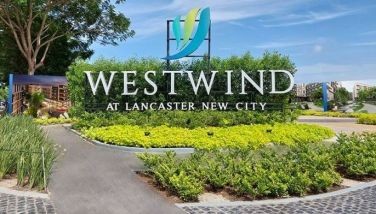Heroes' shrines

A bamboo gate across a dirt road leads to the shrine built in Cavite in honor of Andres Bonifacio.
It is a primitive gate – the type where you have to pull out one by one the bamboo stems laid horizontally so the gate will swing open.
The gate is a short drive from a grassy clearing that I thought was the end of the road. There a man outside a hut told us to make sure we keep the gate closed or else the grazing cows might wander out.
At least the man seemed aware of the existence of the shrine at the end of the road, on Mount Nagpatong near Mount Buntis. Last Maundy Thursday, we drove around Cavite’s scenic Maragondon town, ending up in Puerto Azul in Ternate before deciding to retrace our route after cops in two “Lakbay Lansangan” stations seemed clueless about the way to the Bonifacio Shrine.
A grizzled tricycle driver finally gave the accurate directions. At the end of a narrow road in Barangay Ul-Ong a small sign attached to an electric post announced, “Bonifacio Shrine, this way.”
The road became paved several hundred meters beyond the bamboo gate. At the end of the short paved stretch a metal gate welcomed visitors to the Bonifacio Shrine and Eco-Tourism Park.
For a fee of P20, one can see the giant figures of the brothers Andres and Procopio Bonifacio, their hands and feet bound, shortly before they were executed somewhere around that spot on May 10, 1897 “by order of the military tribunal of the revolutionary government” of Emilio Aguinaldo, according to a plaque.
It is an impressive shrine, with metalwork depicting the brothers’ revolutionary struggles. But a separate section, with the scenes fashioned it seems out of papier-mâché, is deteriorating.
Across the shrine is a pavilion, with a small shop selling souvenirs from Maragondon: lamps and knickknacks made of bamboo. Nothing about the revolution. There was no running water in the restrooms.
The court martial was headed by Brig. Gen. Mariano Noriel, who according to several accounts was also Andres Bonifacio’s executioner. Noriel is not mentioned at the shrine, but his name is in the markers at the house in Maragondon where the Bonifacio brothers were tried after a leadership fight with Aguinaldo, a Cavite native.
The “Trial House,” owned by Teodorico Reyes, is well maintained by the National Historical Institute.
It’s a long, tortuous way by horse ride from the Trial House to the execution site, so our founding fathers must have taken pains to conceal the killing of the Bonifacio brothers. Perhaps this ugly chapter in our nation’s history led to amnesia in Cavite about things related to Bonifacio, including his shrine.
As one travel blogger wrote, nobody in Cavite seems to know where the shrine is. From his blog I learned to look for the dirt road and the bamboo gate, which would indicate that I was on the right track. One detail was supplied by the elderly caretaker at the eco-tourism park: the sign to the shrine is primitive and installed high up on the post, he said, because previous signs were always stolen.
At least the shrine was open on Maundy Thursday. There was only one group of visitors when we arrived.
Leaving the shrine we had to avoid the cows that roamed freely. I liked the rustic charm, but we need to treat these monuments to our heroes with more respect. This is Andres Bonifacio, after all, not just some little known Katipunero.
We have an annual day to honor the valor of our war heroes. Surely Bonifacio’s courage in taking up arms against a superior enemy – Jose Rizal might have regarded it as foolhardiness – deserves better treatment.
* * *
The Aguinaldo Shrine in Kawit, where the Declaration of Independence was read by Aguinaldo (the declaration refers to him as “the dictator”) from the balcony of his house, gets that respect. It is well maintained, and all the cops at the “Lakbay Lansangan” stations knew where it is.
The Maragondon Church, built in 1618 by the Jesuits (with the stone structure built in 1714) is also well maintained. In May 1897, it served as headquarters of the Aguinaldo government.
Kawit is now easily accessible from Metro Manila. From the southern tip of the Coastal Road in Las Piñas, Kawit is just a four-minute leisurely drive across the “Cavitex” – the new road built across Manila Bay, with a great view of the bay and the fishing villages and beach resorts of Cavite.
Too bad the road will be a luxury for those who cannot afford the one-way toll of P64 imposed by the Public Estates Authority Toll Corp. Why do Filipinos, who are charged a Road User’s Tax, have to keep paying steep tolls (with VAT) for this basic service that the government is supposed to provide? Toll rates can be so high they constitute highway robbery.
Perhaps Aguinaldo’s descendant, Cavite Rep. Joseph Emilio Aguinaldo Abaya, manager of the House prosecution team in the impeachment trial and chairman of the House appropriations committee, can do something about this.
The toll was the other ugly part of my trip, aside from the neglect of historical sites.
Bonifacio’s shrine isn’t the only one that can use improvement. We also had difficulty finding signs pointing to the site of the Tejeros Convention, at “Casa Hacienda” in Rosario, despite the fact that its 115th anniversary together with that of the Philippine Army was celebrated just last March 22. The convention was when the Aguinaldo and Bonifacio factions met and elected the president and vice president of the revolutionary government (and where the idea of eliminating Bonifacio germinated).
Casa Hacienda was burned down during World War II and its original architecture was not restored. A renovated version was opened to the public, fronted by a giant statue of Aguinaldo, in 1997. The riverside dock (and escape route) of Aguinaldo’s forces plus an underground drain to the river are intact, although facing the garbage of Tanza on the other side. A tunnel leading all the way to the Aguinaldo Shrine, unfortunately, has been sealed.
The actual site of the convention, in the cellar, is in bad shape and closed to the public, according to a caretaker who was friendly and helpful but clearly lacking in training as a tourist guide.
With the Cavitex, the province could enjoy a boost in so-called Heritage Tours. But first someone must make sure Cavite cops, tasked to assist tourists, are aware of the integral components of such tours, particularly the Bonifacio Shrine.
- Latest
- Trending






















